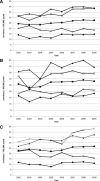Trends in incidence of type 1 diabetes among non-Hispanic white youth in the U.S., 2002-2009
- PMID: 24898146
- PMCID: PMC4207387
- DOI: 10.2337/db13-1891
Trends in incidence of type 1 diabetes among non-Hispanic white youth in the U.S., 2002-2009
Abstract
The SEARCH for Diabetes in Youth Study prospectively identified youth aged <20 years with physician-diagnosed diabetes. Annual type 1 diabetes (T1D) incidence per 100,000 person-years (95% CI) overall, by age-group, and by sex were calculated for at-risk non-Hispanic white (NHW) youth from 2002 through 2009. Joinpoint and Poisson regression models were used to test for temporal trends. The age- and sex-adjusted incidence of T1D increased from 24.4/100,000 (95% CI 23.9-24.8) in 2002 to 27.4/100,000 (26.9-27.9) in 2009 (P for trend = 0.0008). The relative annual increase in T1D incidence was 2.72% (1.18-4.28) per year; 2.84% (1.12-4.58) per year for males and 2.57% (0.68-4.51) per year for females. After adjustment for sex, significant increases were found for youth aged 5-9 years (P = 0.0023), 10-14 years (P = 0.0008), and 15-19 years (P = 0.004) but not among 0-4-year-olds (P = 0.1862). Mean age at diagnosis did not change. The SEARCH study demonstrated a significant increase in the incidence of T1D among NHW youth from 2002 through 2009 overall and in all but the youngest age-group. Continued surveillance of T1D in U.S. youth to identify future trends in T1D incidence and to plan for health care delivery is warranted.
© 2014 by the American Diabetes Association. Readers may use this article as long as the work is properly cited, the use is educational and not for profit, and the work is not altered.
Figures
References
-
- Dabelea D, Bell RA, D’Agostino RB, Jr, et al. Writing Group for the SEARCH for Diabetes in Youth Study Group . Incidence of diabetes in youth in the United States. JAMA 2007;297:2716–2724 - PubMed
-
- Onkamo P, Väänänen S, Karvonen M, Tuomilehto J. Worldwide increase in incidence of Type I diabetes—the analysis of the data on published incidence trends. Diabetologia 1999;42:1395–1403 - PubMed
-
- DIAMOND Project Group . Incidence and trends of childhood type 1 diabetes worldwide 1990-1999. Diabet Med 2006;23:857–866 - PubMed
-
- Patterson CC, Dahlquist GG, Gyürüs E, Green A, Soltész G, EURODIAB Study Group . Incidence trends for childhood type 1 diabetes in Europe during 1989-2003 and predicted new cases 2005-20: a multicentre prospective registration study. Lancet 2009;373:2027–2033 - PubMed
Publication types
MeSH terms
Grants and funding
- U01 DP000247/DP/NCCDPHP CDC HHS/United States
- U18 DP002710/DP/NCCDPHP CDC HHS/United States
- U18 DP006134/DP/NCCDPHP CDC HHS/United States
- UL1 TR000154/TR/NCATS NIH HHS/United States
- U18 DP002714/DP/NCCDPHP CDC HHS/United States
- U01 DP000248/DP/NCCDPHP CDC HHS/United States
- U01 DP000244/DP/NCCDPHP CDC HHS/United States
- UL1 RR029882/RR/NCRR NIH HHS/United States
- U18 DP002709/DP/NCCDPHP CDC HHS/United States
- UL1 TR002319/TR/NCATS NIH HHS/United States
- UL1 TR000423/TR/NCATS NIH HHS/United States
- U01 DP000250/DP/NCCDPHP CDC HHS/United States
- U18 DP002708/DP/NCCDPHP CDC HHS/United States
- P30 DK017047/DK/NIDDK NIH HHS/United States
- P30 DK057516/DK/NIDDK NIH HHS/United States
- HIR 10-001/HX/HSRD VA/United States
- K23 DK089017/DK/NIDDK NIH HHS/United States
- UL1 TR000077/TR/NCATS NIH HHS/United States
- U01 DP000246/DP/NCCDPHP CDC HHS/United States
- U01 DP000254/DP/NCCDPHP CDC HHS/United States
LinkOut - more resources
Full Text Sources
Other Literature Sources
Medical


